Congo: Kayaking the Ngongo
Last week my friend Tim (a whale researcher who lives at Conkouati) and I took off on a 3 day trip in search of manatees to lakes and up the Ngongo River north of Conkoauti Lagoon. People on the lagoon told me manatees occur in these more remote areas, so I was eager to go look. Our Congolese boat driver, Christian, works for Conkouati national park and knows these waterways very well.
Boating up the Ngongo River towards Lac Tchibinda on the first day, we passed through raffia palm forest which is full of elephants at this time of year, then moved into more upland tropical forest in the north. It was slow going due to many fallen logs in the river. Lac Tchibinda is enormous! It took us an entire day to slowly boat around the edges. There are only a few people who live permanently on Lac Tchibinda, although there are a number of camps and people come occasionally to fish.
Lac Tchibinda is enormous! It took us an entire day to slowly boat around the edges. There are only a few people who live permanently on Lac Tchibinda, although there are a number of camps and people come occasionally to fish. Overall the habitat is very pristine. Tim saw 4 otters on his morning kayak near our camp, and I found hundreds of duiker tracks (they’re like a small deer) on the shore. It’s quiet and good manatee habitat, but unfortunately we didn’t see any. You can see the waterline on the bottom of the trees in the photo below, which marks the water level rise in the rainy season.
Overall the habitat is very pristine. Tim saw 4 otters on his morning kayak near our camp, and I found hundreds of duiker tracks (they’re like a small deer) on the shore. It’s quiet and good manatee habitat, but unfortunately we didn’t see any. You can see the waterline on the bottom of the trees in the photo below, which marks the water level rise in the rainy season. Our peaceful campsite on the lake. It’s dry season, so very cool at night.
Our peaceful campsite on the lake. It’s dry season, so very cool at night.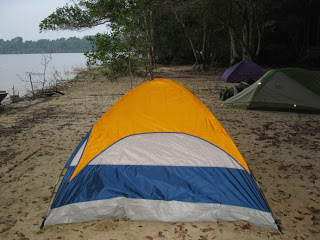 Ready to kayak in the land of too many tse tse flies! The first morning we went in opposite directions in our kayaks in order to cover more area at first light.
Ready to kayak in the land of too many tse tse flies! The first morning we went in opposite directions in our kayaks in order to cover more area at first light. Sunrise view of the lake from the shoreline
Sunrise view of the lake from the shoreline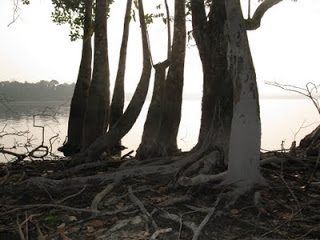 I found freshwater mussels and collected samples. They were quite large, about 3 inches long. Now that I’ve really started looking, it turns out I find shellfish everywhere manatees are reported in Africa.
I found freshwater mussels and collected samples. They were quite large, about 3 inches long. Now that I’ve really started looking, it turns out I find shellfish everywhere manatees are reported in Africa.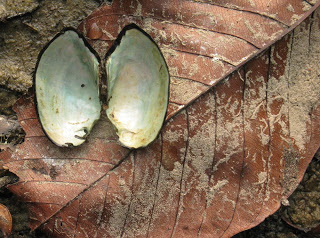 After the morning kayak we loaded up our motor boat & headed off on a survey around the rest of Lac Tchibinda. At the mouth of a small river that drains into the lake, there was a large grassy area with many species of manatee food plants. A local fisherman I interviewed that day told me he often sees manatees here as well as within the river, and he described mating herds, which was the first report of them I’ve had at Conkouati. The river was too small to navigate in our motorized boat and we had to keep going to finish Tchibinda and get to the next site, so no time to kayak it that day.
After the morning kayak we loaded up our motor boat & headed off on a survey around the rest of Lac Tchibinda. At the mouth of a small river that drains into the lake, there was a large grassy area with many species of manatee food plants. A local fisherman I interviewed that day told me he often sees manatees here as well as within the river, and he described mating herds, which was the first report of them I’ve had at Conkouati. The river was too small to navigate in our motorized boat and we had to keep going to finish Tchibinda and get to the next site, so no time to kayak it that day. 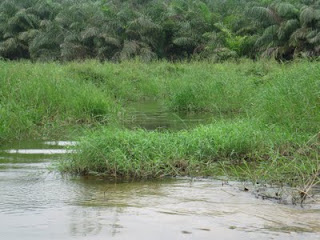 While I checked out the river mouth, Tim caught his first fish of the trip (which was released)
While I checked out the river mouth, Tim caught his first fish of the trip (which was released)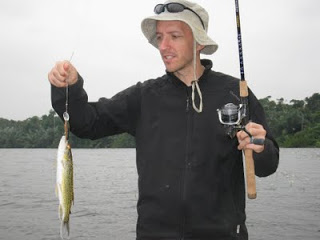 At another small river that drains into the lake we saw elephant tracks… but still no manatees.
At another small river that drains into the lake we saw elephant tracks… but still no manatees.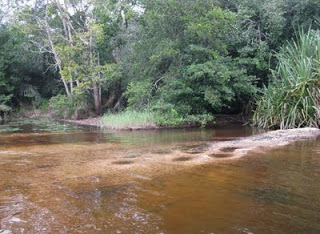 After interviewing a local fisherman I wrote up my notes before we continued. People are often less intimidated when I don’t take notes as I interview them. (photo by T. Collins).
After interviewing a local fisherman I wrote up my notes before we continued. People are often less intimidated when I don’t take notes as I interview them. (photo by T. Collins). As we headed from Lac Tchibinda over to the Ngongo River we passed this banded cobra (Boulengerina annulata) sunning just above the water.
As we headed from Lac Tchibinda over to the Ngongo River we passed this banded cobra (Boulengerina annulata) sunning just above the water. Boating quickly up the Ngongo to reach our camp by sunset. Despite the beautiful scenery, I start to get frustrated when I don’t find manatees! (photo by T. Collins).
Boating quickly up the Ngongo to reach our camp by sunset. Despite the beautiful scenery, I start to get frustrated when I don’t find manatees! (photo by T. Collins).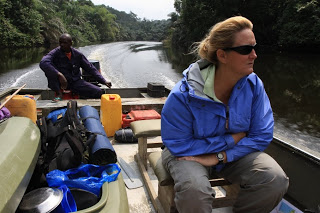 As we came around one corner, we surprised a female elephant bathing in the river. We also saw and heard many other eles feeding along the banks.
As we came around one corner, we surprised a female elephant bathing in the river. We also saw and heard many other eles feeding along the banks. Happy campers part 2: Tim & Christian in the early morning mist of the Ngongo. Tim is just happy that he survived the night without an elephant tromping on his tent!
Happy campers part 2: Tim & Christian in the early morning mist of the Ngongo. Tim is just happy that he survived the night without an elephant tromping on his tent!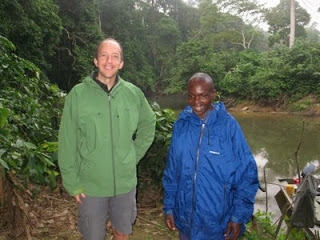 Early the next morning we kayaked down the Ngongo River. The current is pretty strong, so we were able to mostly drift and look for wildlife. We saw lots of monkeys & chimps, hundreds of hornbills and other birds, and we heard elephants feeding in the brush above us. (photo by T. Collins).
Early the next morning we kayaked down the Ngongo River. The current is pretty strong, so we were able to mostly drift and look for wildlife. We saw lots of monkeys & chimps, hundreds of hornbills and other birds, and we heard elephants feeding in the brush above us. (photo by T. Collins).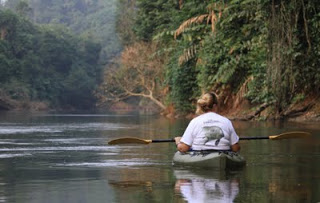 The banks of the river rose about 20-30 feet above the waterline, indicating how much higher the water rises during the rainy season. This whole area floods, and as in other rivers I’ve surveyed in Africa, it’s possible that manatees swim into flooded forests on the rivers edge at that time of year. But now it’s the dry season and upriver the vegetation is too far above the waterline for manatees to reach, so I wasn’t surprised not to find them here. Further downriver, though, the embankments are not as high (the river gets wider & deeper) and manatees could use that area in all seasons.
The banks of the river rose about 20-30 feet above the waterline, indicating how much higher the water rises during the rainy season. This whole area floods, and as in other rivers I’ve surveyed in Africa, it’s possible that manatees swim into flooded forests on the rivers edge at that time of year. But now it’s the dry season and upriver the vegetation is too far above the waterline for manatees to reach, so I wasn’t surprised not to find them here. Further downriver, though, the embankments are not as high (the river gets wider & deeper) and manatees could use that area in all seasons.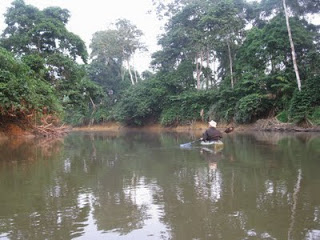 This is just another photo to give a sense of the gorgeous forest habitat. (photo by T. Collins).
This is just another photo to give a sense of the gorgeous forest habitat. (photo by T. Collins).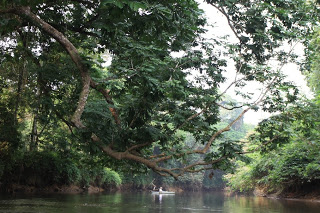 At least we had a beautiful kayak trip and saw some cool animals. This is a Great Blue Turaco, one of several we saw as we paddled the river. They are about the size of a hawk. It’s hard to photograph them so I was lucky.
At least we had a beautiful kayak trip and saw some cool animals. This is a Great Blue Turaco, one of several we saw as we paddled the river. They are about the size of a hawk. It’s hard to photograph them so I was lucky.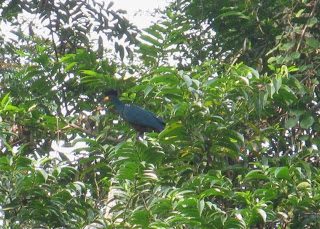 We also saw these pretty purple flowers that reminded me of wisteria.
We also saw these pretty purple flowers that reminded me of wisteria. Next we continued to Lac Tchimpa….
Next we continued to Lac Tchimpa….
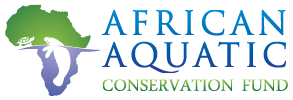
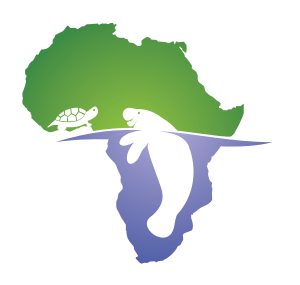
Hello!
I'm pretty sure the first snake isn't a Grayia but a water banded cobra (Boulengerina annulata), very common in Conkouati
Ok, thanks! I don't know my snakes very well and it looks very similar to Grayia's I've seen in Gabon, so thank you for the correction! I'll change it in the post.
Cheers, Lucy